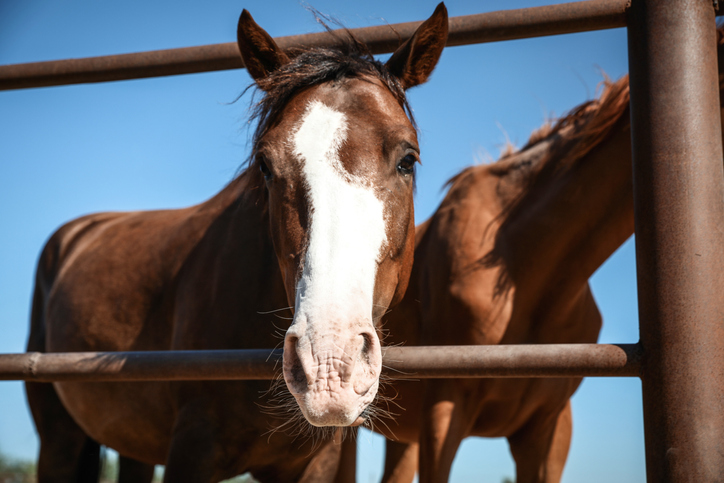Bill seeks to ban horse slaughter, exportation for slaughter
- February 20, 2024
- ⎯ Edited Press Release
Here in the United States, the last operational horse slaughter plants were shuttered in 2007 after two state-level prohibitions, followed by defunding of the requisite U.S. Department of Agriculture inspections, which effectively launched a moratorium on domestic horse slaughter for human consumption.
Yet the topic of equine slaughter is still debated at the state and federal levels, and the systematic export of American horses to foreign slaughterhouses continues.
Therefore, animal welfare advocates, highlighting not only ethical and welfare issues but public health concerns, continue to push for the passage of the Save America’s Forgotten Equines (SAFE) Act. If it becomes law as currently written, this bill will not only permanently ban domestic horse slaughter for human consumption but prohibit the “shipping, transporting, possessing, purchasing, selling or donating an equine to be slaughtered for human consumption or equine parts for human consumption.” The bill’s latest versions, H.R. 3475 and S. 2037, represent a bipartisan effort and were introduced to the Senate and the House of Representatives last summer.
‘No easy answers’
According to the American Society for the Prevention of Cruelty to Animals (ASPCA), approximately 19,600 American horses were “trucked over our borders to be slaughtered for human consumption” in 2022 alone. Drilling down deeper into the statistics, the Horse Welfare Collective states on its website that roughly 83% of the horses sent to slaughter are purchased by kill buyers who ship the horses to Mexico and Canada to be slaughtered for this purpose.

However, as equine welfare advocates well recognize, the issue of horse slaughter in this country is a complex and controversial one, with “no easy answers.”
For example, both the HWC and the Humane Society of the United States (HSUS) contend that more than 80% of Americans are against horse slaughter, with the majority viewing horses as companion and performance animals rather than livestock. Yet, according to a U.S. Department of Agriculture study that the HWC quotes on its website, the majority of horses sent to slaughter in the U.S. are “young and adoptable.” Along these same lines, the HSUS maintains that 92.3% of American horses sent to slaughter “are healthy and would be able to live out happy lives if given the chance.”
Out of options?
Once believed by some to provide a humane end-of-life option for aged, infirm or “unwanted” horses, the slaughter industry has instead been condemned for unethical and inhumane practices by equine welfare advocates.
However, there is also concern about what would happen to all the “unwanted” horses should slaughter be removed as an end-of-life option for those animals that seemingly have no other options. If legislators completely eliminated this option, some worry: Would the number of abused and abandoned horses increase?
To this, the HWC responds that according to the Equine Welfare Data Collective, there is a daily rescue capacity for around 47,000 horses in rescue facilities—suggesting that there are indeed enough safe homes for at-risk horses in this country each year. And a quick survey of animal welfare websites yields an array of worthwhile ideas for the rehabilitation and repurposing of these often forgotten horses.
Impacts of horse slaughter on welfare
According to the HWC and the HSUS, slaughter impacts equine welfare for these reasons:
-It is impossible to humanely slaughter horses due to their physiology. For more information about this, visit this page.
-It has been documented that horses are subject to significant abuse and suffering once in the slaughter pipeline.
-The USDA is unable to enforce horses-for-slaughter welfare and disease traceability.
Public health impacts
The HWC and the HSUS also contend that horse slaughter can impact public health in these ways:
-American horse meat is unsafe to eat since many medications commonly used in horses here are FDA-banned for use in animals intended for human consumption.
-Individuals might be exposed to harmful horse slaughter byproducts even if they choose not to eat horse meat.
-American horse meat might be present in the U.S. commercial market as imported meat mislabeled as ground beef.
A call to action
To become law, the SAFE Act needs to pass in the House of Representatives, and then in the Senate. This is not a quick or easy process, as the history of the bill’s previous iterations illustrates.
For more background information on this issue, including statistics and suggested actions, visit the HWC’s webpage on the SAFE Act and/or the HSUS page on horse slaughter.
P.S.: Horse selling tips
Finally, to help ensure a horse you are selling does not end up on a slaughter truck, the HWC offers these suggestions:
- Steer clear of livestock auctions. They are the number-one entry point into the horse slaughter pipeline.
- Sell your horse for at least $900. This removes the profit margin for slaughter. If selling a draft horse, ask at least $1,400.
- Know your buyer. Ask for a recommendation from that person’s vet and for three references in the equestrian community.
- Draw up a bill of sale that prohibits the sale of the horse for slaughter and includes a first right of refusal.
- If the horse has registration papers, put a sticker on the papers that states the horse is not to be sold to slaughter, and provide a number to call if the horse needs a new home.





